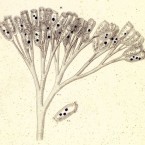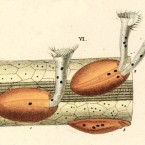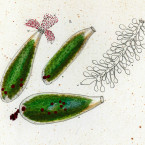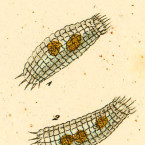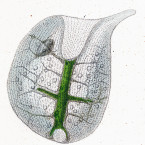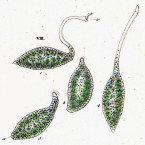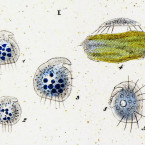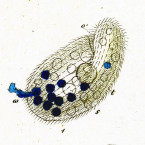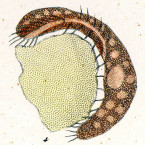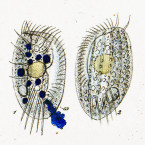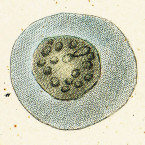Illustrations of Ciliates
from Die Infusionsthierchen als vollkommene Organismen, 1838
In this collection of images, I’ve kept Ehrenberg’s original names and preserved his idiosyncratic taxonomy and nomenclature, which were based largely on the arrangement of the alimentary and digestive organs he believed he could see in the bodies of the microscopic infusoria. In his system, the ciliates were placed, along with the flagellated and amoeboid infusoria, in the class Polygastrica: creatures with many stomachs. Within this class were 22 families, of which 10 were mostly made up of what we now recognize as ciliates. Based, as they were, on the erroneous polygastric hypothesis, these families will seem odd to modern readers. Unrelated organisms are often placed together, while members of the same genus–and even, in the case of Lacrymaria olor, the same species–are sometimes distributed among separate families. A few non-ciliates found their way into these families; for instance, Ehrenberg placed the euglenoid flagellate Peranema in his family Trachelina (evidently, interpreting the flagellum as a proboscis), and the stalked choanoflagellate Codosiga botrytis was placed in the genus Epistylis. The heliozoan Actinophrys was placed in the family Enchelia, alongside the suctorian ciliate Podophrya. I’ve omitted these interlopers from the collection.
The images shown here were all pulled from Ehrenberg’s huge colour plates (19 X 13 inches in size), which placed large numbers of organisms together on a single page. I’ve used photoshop to select out individual organisms, and improve clarity and contrast. In brightening up the faded originals, I don’t pretend to have restored them to their original appearance. I did not worry too much about the fidelity of the color, since my concerns here are mainly taxonomic and not archival.
When modern synonyms for a species are known, I’ve added these in parentheses.
Composition of Ehrenberg’s ciliate families
Vorticellina — Polygastric animals with a distinct alimentary canal, mouth and anus separate, but meeting in the same cavity. No lorica. Solitary and free-living, or attached and social, reproducing by unequal spontaneous division, often in the form of beautiful little trees. (This family includes reconizable species of Stentor, many kinds of stalked peritrichs, Trichodina and the peniculine Urocentrum)
Ophrydina — Polygastric animals, solitary or gregarious, mouth and anus separate but meeting in a common cavity, body enclosed in a shell. =Loricate Vorticellines. (This family includes loricates, such as Ophrydium, Vaginicola, Cothurnia, as well as tintinnids)
Enchelia — Polygastric animals with a distinct digestive canal, mouth and anus at opposite extremities of the body, with no lorica. =Naked Colepina. (A diverse family, including recognizable species of Enchelys, Spathidium, Climacostomum, Podophrya, Tetrahymena, Lacrymaria, holophryids and various unidentifiable ciliates)
Colepina — Polygastric animals, enclosed in a lorica, with a distinct alimentary canal, mouth and anus at opposite extremities of the body. =Loricate Enchelia. (A single-genus family, containing Coleps)
Trachelina — Polygastric animals, alimentary canal with two distinct orifices, of which only the anus is terminal. No lorica. (A very diverse family, including species of Trachelius, Loxodes, Bursaria, Frontonia leucas and F. vernalis, Climacostomum virens, Phialina, Spirostomum ambiguum, Glaucoma, chilodonellids, Nassulopsis, Nassula, Obertrumia, Dileptus, Pseudomonilicaryon, possibly certain pleurostomatids and what looks like a long Condylostoma misidentified as Spirostomum)
Ophryocercina — Polygastric animals, alimentary canal with two distinct orifices, of which only the mouth is terminal. No lorica. (This family includes recognizable species of Trachelius, Litonotus, Dileptus, Lacrymaria)
Aspidiscina — Polygastric animals with lorica; alimentary canal with two distinct orifices, of which only the mouth is terminal. (A single genus family, including certain species of Aspidisca).
Kolpodea — Polygastric animals without lorica; alimentary canal with two distinct orifices, of which neither the mouth nor the anus is terminal. (A diverse family, including species of Colpoda, Paramecium, Pleuronema, Colpidium, Uroleptus, Paruroleptus, Ophryoglena, Mucotrichidium, Spirostomum and Frontonia).
Oxytrichina —
Euplota —
